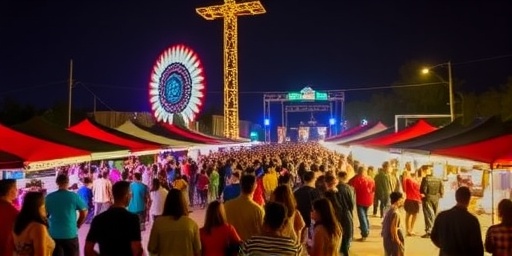Chandler, Arizona, pulsed with vibrant energy today as the annual Indian Frybread & Arts Festival kicked off under sunny skies, attracting thousands eager for a taste of Native American heritage through sizzling frybread, mesmerizing live entertainment, and intricate arts displays. What started as a modest community gathering two decades ago has ballooned into one of the Southwest’s premier cultural events, blending culinary traditions with performances that echo the rhythms of indigenous cultures across the nation.
- Frybread Frenzy: Vendors Serve Up Crispy Delights and Traditional Twists
- Stage Lights and Drum Beats: Live Entertainment Captivates Multigenerational Crowds
- Artistic Expressions: Showcasing Indigenous Crafts and Modern Innovations
- Community Ties: How the Festival Strengthens Arizona’s Native Heritage
- Weekend Ahead: Must-See Highlights and Practical Tips for Visitors
Frybread Frenzy: Vendors Serve Up Crispy Delights and Traditional Twists
The air at Tumbleweed Ranch Park was thick with the irresistible aroma of frying dough, signaling the heart of the Indian Frybread Festival‘s appeal. Dozens of food vendors lined the festival grounds, each offering their unique spin on the iconic frybread—a staple born from necessity during the long marches of Native American relocation in the 19th century. Organizers estimate over 15,000 attendees on opening day alone, many drawn by the promise of this simple yet profound dish topped with everything from savory meats and beans to sweet honey and powdered sugar.
"Frybread isn’t just food; it’s a story on a plate," said Maria Tsosie, a Navajo vendor who’s been perfecting her recipe for 25 years. Her stall, Tsosie’s Traditional Treats, featured a line stretching 50 feet long by noon. Tsosie explained how her grandmother adapted the bread using government-issued rations during the Trail of Tears era, turning hardship into a symbol of resilience. This year, she’s innovated with gluten-free options using cornmeal, catering to health-conscious festival-goers while honoring the dish’s roots.
Beyond frybread, the culinary scene expanded to include wild game stews, handmade tamales, and frybread tacos infused with regional Arizona flavors like green chiles and prickly pear salsa. Vendors reported brisk sales, with one, the Hopi Heritage Kitchen, projecting $10,000 in revenue over the three-day event. Health experts from the Arizona Department of Health were on-site, promoting balanced eating amid the indulgences, noting that frybread’s cultural significance outweighs its caloric density when enjoyed in moderation.
The festival’s food court wasn’t just about eating; it fostered connections. Families gathered at communal picnic tables, sharing stories as children chased each other around the grounds. One attendee, Carlos Rivera, a Phoenix resident of Mexican descent, shared, "I’ve never had frybread like this—it’s a bridge between my culture and Native traditions. Events like this make Arizona feel like one big family."
To keep things organized, vendors operated under strict hygiene protocols post-pandemic, with hand sanitizer stations every 20 feet and contactless payment options. This attention to detail has helped the Indian Frybread Festival maintain its reputation as a safe, inclusive cultural event in Arizona.
Stage Lights and Drum Beats: Live Entertainment Captivates Multigenerational Crowds
As the sun dipped toward the horizon, the main stage came alive with a thunderous drum circle that reverberated through the park, pulling spectators into the pulse of Native American live entertainment. The festival’s lineup, curated by the Arizona Native Arts Collective, featured a diverse array of performers from tribes across the Southwest, including the Navajo Nation, Hopi, and Tohono O’odham. Headliners like the Grammy-nominated group Black Lodge Singers kicked off the evening with powwow songs that blended traditional chants with contemporary beats, drawing cheers from a crowd estimated at 5,000.
Live entertainment at the Indian Frybread Festival isn’t mere spectacle; it’s a vital thread in preserving oral histories and languages. Performer Lena Begay, a Diné (Navajo) flutist, took the stage at 3 p.m., her haunting melodies evoking the canyons of her homeland. "Music is our medicine," Begay told the audience during a brief interlude. "In Arizona’s fast-paced world, these songs remind us to slow down and listen to the earth." Her set, which included original compositions inspired by Monument Valley, resonated deeply, with many in the crowd closing their eyes in quiet reverence.
The afternoon schedule was packed: hoop dancers from the San Carlos Apache Tribe dazzled with gravity-defying spins, while a youth ballet folklorico group from the Salt River Pima-Maricopa community infused Mexican-indigenous fusion dances. For families, interactive workshops preceded the shows, teaching basic drum rhythms to kids as young as five. Organizers reported over 2,000 participants in these sessions, highlighting the festival’s role in intergenerational education.
Technical glitches were minimal, thanks to upgraded sound systems funded by a $50,000 grant from the Arizona Commission on the Arts. This investment ensured crystal-clear audio, even as wind gusts swept through the desert venue. Evening fireworks synced to indigenous music capped the day, a spectacle that left attendees buzzing about tomorrow’s acts, including a surprise guest from the Cherokee Nation.
Live entertainment extended beyond the main stage to pop-up venues: storytellers under shaded tents recounted legends of Coyote the Trickster, while jugglers and fire spinners added whimsy. This multifaceted approach made the cultural event accessible, ensuring no one left without a moment of wonder.
Artistic Expressions: Showcasing Indigenous Crafts and Modern Innovations
Wandering the artisan alleys of the Indian Frybread & Arts Festival revealed a treasure trove of creativity, where ancient techniques met bold contemporary designs. Over 100 booths displayed works from Native artists, from intricately beaded jewelry to monumental pottery sculptures, underscoring the festival’s commitment to the arts as a living legacy. Sales were robust, with the collective generating an estimated $75,000 in the first hours, supporting artists who often struggle in mainstream markets.
One standout was the exhibit by Zuni Pueblo silversmith Elias Quam, whose turquoise-inlaid rings drew admirers from as far as California. "Each piece carries a prayer," Quam said, demonstrating his stamping technique passed down through seven generations. His work, priced from $50 to $500, blended traditional fetishes—small animal carvings symbolizing protection—with modern minimalist aesthetics, appealing to younger buyers seeking cultural authenticity without ostentation.
The arts section also featured interactive elements, like a communal mural where attendees painted symbols of unity using natural pigments. Led by artist and educator Tanya Honyouti from the Hopi Tribe, the project aimed to create a 20-foot canvas reflecting shared Arizona stories. By midday, it was half-complete, with contributions from elders, children, and tourists alike. "Art heals divides," Honyouti noted. "In this cultural event, we’re not just displaying; we’re co-creating."
Beyond visuals, the festival spotlighted performing arts through theater vignettes depicting historical events like the Long Walk of the Navajo. These 15-minute pieces, enacted by local youth, educated while entertaining, with scripts vetted by tribal historians for accuracy. Statistics from past festivals show such programs increase attendees’ cultural knowledge by 40%, per a University of Arizona study.
Sustainability was woven into the arts narrative: many pieces used recycled materials, like reclaimed wood for dreamcatchers, aligning with indigenous stewardship values. Booths included educational placards explaining sourcing ethics, educating shoppers on supporting ethical Native economies. This depth transformed the Indian Frybread Festival into more than a market—it’s a classroom for cultural appreciation in Arizona.
Community Ties: How the Festival Strengthens Arizona’s Native Heritage
Deep in the heart of the Sonoran Desert, the Indian Frybread & Arts Festival serves as a beacon for Arizona’s 22 federally recognized tribes, fostering unity amid historical challenges. Launched in 2003 by the Chandler Cultural Foundation, the event has grown from 500 visitors to a projected 50,000 over the weekend, injecting $2 million into the local economy through tourism and vendor spending. Mayor Kevin Hartke proclaimed it "Chandler’s crown jewel," emphasizing its role in promoting inclusivity.
Local impacts are tangible: proceeds fund scholarships for Native youth, with last year’s $30,000 aiding 50 students at Arizona State University. Organizers, led by executive director Rosa Nez, prioritized tribal input, forming an advisory council that ensures authentic representation. "This isn’t a tourist trap; it’s a homecoming," Nez stated in her opening remarks. "In Arizona, where Native history is foundational, events like this reclaim our narratives."
Challenges persist, from funding droughts to weather uncertainties, but community partnerships shine. Collaborations with the Heard Museum provided expert-led tours, while schools integrated festival themes into curricula, reaching 10,000 students statewide. Attendee feedback via on-site surveys showed 95% satisfaction, praising the blend of tradition and accessibility.
The festival also addresses broader issues like mental health, with quiet reflection spaces offering smudging ceremonies—rituals using sage for cleansing. Counselors from the Indian Health Service were available, recognizing the emotional weight of cultural reconnection. For many, like veteran attendee Samuel Yazzie, it’s therapeutic: "Coming here mends the spirit. Frybread, songs, art—they all remind me who I am."
As Arizona grapples with growth, the Indian Frybread Festival models sustainable cultural tourism, balancing preservation with progress. It’s a reminder that in the Grand Canyon State, heritage isn’t relic—it’s alive, evolving, and essential.
Weekend Ahead: Must-See Highlights and Practical Tips for Visitors
With day one setting a high bar, the Indian Frybread & Arts Festival promises even more thrills through Sunday. Saturday’s marquee event is a celebrity chef cook-off at 1 p.m., pitting tribal cooks against Arizona’s top restaurateurs in a frybread showdown judged by local influencers. Expect fusion creations like lobster-topped frybread, blending coastal influences with desert staples. Live entertainment escalates with the R. Carlos Nakai flute ensemble at dusk, whose ethereal sounds have headlined global stages.
Sunday wraps with a grand powwow parade, featuring 200 dancers in regalia parading through Chandler’s streets before returning for awards. Arts enthusiasts shouldn’t miss the silent auction of one-of-a-kind pieces, with proceeds benefiting youth programs. Organizers anticipate peak crowds then, advising early arrival—gates open at 9 a.m. daily.
Practical tips abound for smooth sailing: Parking at Tumbleweed Ranch fills fast, so shuttle services from downtown Chandler run every 15 minutes for $5. Hydration is key in Arizona’s heat; free water refill stations dot the grounds. For families, kid zones offer face painting and storytelling circles, while accessibility ramps and ASL interpreters ensure inclusivity.
Looking forward, festival planners eye expansion, potentially adding virtual streams for remote Native communities. This evolution could amplify the cultural event’s reach, inspiring similar gatherings nationwide. As Nez envisions, "The Indian Frybread Festival isn’t ending—it’s just beginning to feed souls far beyond our borders." Whether you’re a local or traveler, Chandler beckons with flavors, beats, and beauty that linger long after the last drum fades.









